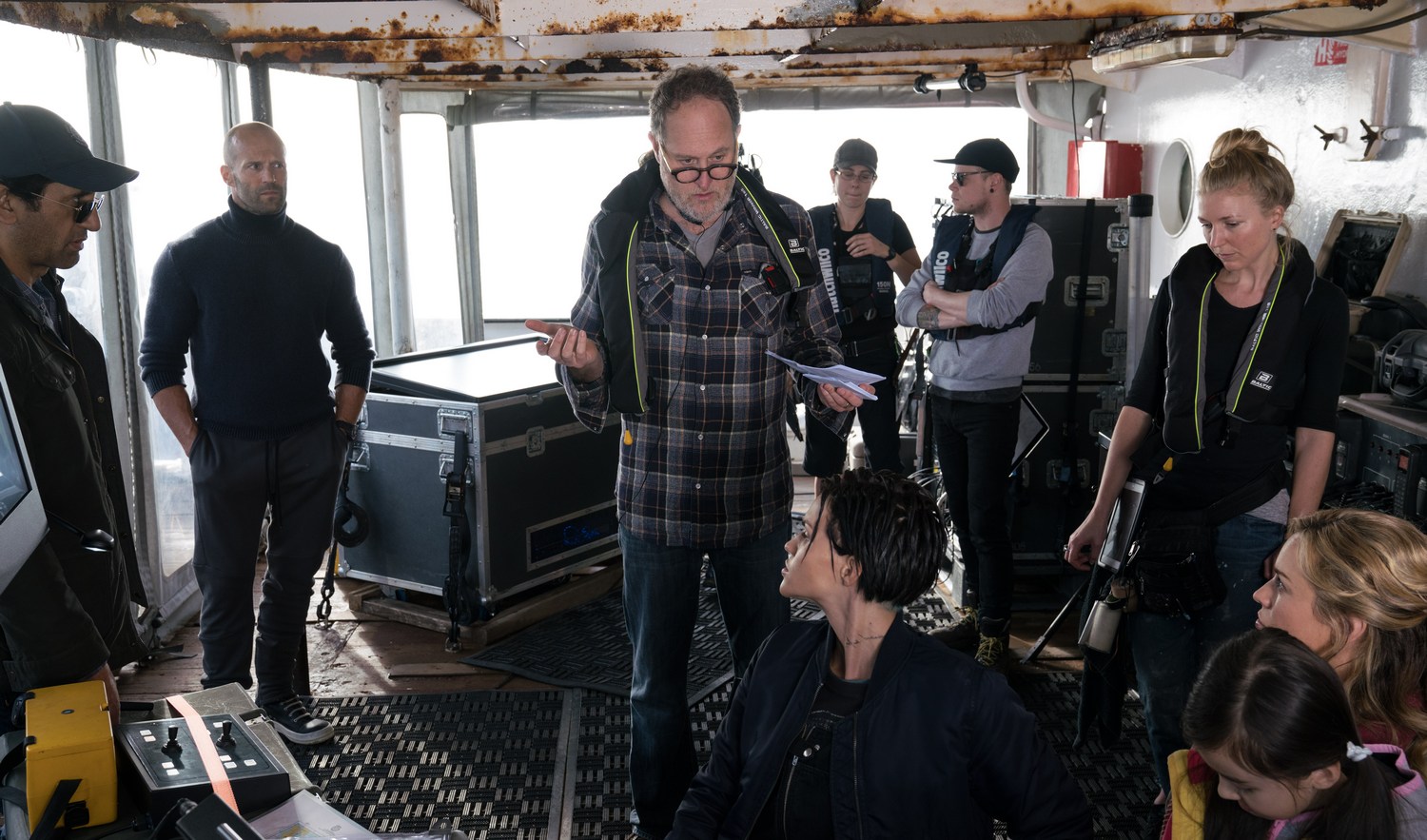Bringing The Meg to Life
Director Jon Turteltaub tells us how he sank his teeth into The Meg.
The Meg can best be described as a good old-fashioned monster movie, with the title beast nothing less than a 75-foot jumbo-sized shark that has somehow survived millions of years after it was thought to be extinct. The creature was the star of a best-selling 1997 novel by Steve Alten — which spawned a whole series of sequels — and plans were afoot for years to bring the tale to the screen even as it got caught up in the vicious teeth of development hell in Hollywood.
Nonetheless, the idea for a movie based on The Meg kept swimming along (sorry) until finally landing at Warner Bros. Pictures, where it finally made its way into production under the direction of Jon Turteltaub (National Treasure, Last Vegas) with a cast headed by action favorite Jason Statham and also including Rainn Wilson, Li Bingbing, Ruby Rose, Cliff Curtis and others, not to mention that incredibly mean and hungry prehistoric shark.
The Meg is more fun than you might expect, partially because it’s self-aware and partially because its cast and director take it just seriously enough to make the basically silly nature of it work. Den of Geek got on the phone with Turteltaub to chew on all this (sorry again), including working with Statham, shooting the movie in giant tanks and on the open sea, and more.
Den of Geek: This has been in development for years, so how did it come your way? How did it evolve from when you got on board?
Jon Turteltaub: Yeah, the development stories I’ve heard, but I wasn’t part of any of them, and by the time it got to me, Lorenzo di Bonaventura was producing and called me up and asked if I’d be interested and sent me the script. So there was a really good script by the time I came aboard. It was already this wonderful partnership between Chinese companies and Warner Bros. So the package was kind of delivered to my door. Really, my job was to just get it across the finish line, and update the script in a way that fit me, which meant for me, take a little step back from making exclusively a big, scary shark movie, and making it more of a fun, playful, self-aware, really big shark movie.
You had not done a sci-fi monster movie before. Was that a challenge you were kind of looking for?
I wasn’t looking, but when it arrived I said to myself, “This is a movie I would see, but I’ve never been offered. Why would I not want to make a movie I would see?” It’s a whole genre I never got to do, but it’s a very clear genre. So for a director, genres really guide you. It’s like different playgrounds. You see that swing, and you go, “Oh, I want to go on that.” You don’t want to just go on the same one you’ve been on a million times. You want to do something a little bit different, but something familiar enough that you know it’s going to be fun. That’s the worst analogy ever. If I were on your website, I’d stop reading right now.
No, I think that makes sense. Any films you looked at in terms of the kind of tone or mood you wanted?
Tonally is where it got very unique. This kind of movie is either overly dramatically and overly fake, or overly campy and silly. I was trying to find a way to really respect, not just the monster movie, but the shark movie, but not overdo the melodrama of the whole thing. To keep it fun, to let the characters in the movie be people who have gone to see shark movies before. They’re aware of the same things the audience is aware of, and they know, and we the filmmakers know what movie we’re making. That seems a little subtle perhaps, but it plays out in a lot of really interesting ways.
The trailers really sold the tone you were going for.
But that’s because of all the work that went into getting those trailers to have that exact same vibe. Because the trailers easily could have been action, action, action, action. Or they could have easily been: Isn’t this a stupid shark movie? And the trailers managed to also capture the feeling of: this is going to be really fun, it’s going to deliver a big budget movie shark movie, but it’s not going to drive you away because you’ve seen it a million times.
It’s fairly faithful to the book in the basic structure and some of the plot points. But what changes did you feel you had to make?
Characters changed a lot. Some characters are combined into one. Some men were turned into women, some women were turned into men. Those kinds of things. We drew on more than one of the novels at a time to bring some of the things we want. But what’s a great about a novel is you’re immersed in it for hundreds and hundreds of pages. A movie you gotta get through it in an hour and a half. So it’s about eliminating things that you can still tell a cool story with and not include. And if you read the novels, you realize there’s going to be a lot left over for other movies.

How did the process go in terms of getting the look of the shark?
Trial and error. A lot of trial and error. We wanted to be sure that the Meg was its own species, not just an oversized version of an existing shark. So a lot of research into, not just how a gigantic shark would be different, but how would a gigantic shark that lives in the oxygen-poor environment 30,000 feet deep in a trench has evolved.
You do all that work, and you just draw picture after picture and do little sculptures, and then the visual effects people do their work, and every time you would change something, it’s expensive, but you still have to do it, and you keep changing it. And yet, just doing it the way you think is cool is very intertwined with what are audience expectations. Because if you make it so different from how audiences see it, they’re not going to believe it. And if you make it exactly the way audiences see it, it’s going to feel cheap. So you’ve got to come up with something new but familiar.
What interesting info did you come across in your own research into all this that you didn’t know before?
Here’s the single most interesting thing I may have ever learned making any movie, let alone this one. I found out that there have been sharks on Earth longer than there have been trees. That flipped me out. And it helps you see how long they have had to become as awesome as they are.
You shot a lot of this in a couple of tanks, which sounds to me, in a good way, kind of old school. Did it make things any easier or harder?
It makes things easier on a physical level. But it makes things harder on a cinematic level, because you have to do so much work to make things look real. Yes, we mixed tank work with open ocean work. Now if you go out and shoot the open ocean on a very wavy day, when you do the tank work, you better make it wavy. It ain’t that easy.
So you’re stuck with those kinds of issues. And when you’re making it wavy, it’s going to be loud. And if it’s loud, then the sound man’s mad at you. And it’s all that kind of stuff that you’re juggling. It’s interesting, because I get asked this kind of stuff a lot, and there’s a ton to tell. And part of me is always thinking, “Who gives a shit? This is my problem, not the audience’s problem. I want them watching the movie, not thinking about tanks.”
I’m always interested in how much directors try to keep the visual effects practical and not digital if they can help it.
You do try to keep as much practical as possible, so as much as you can. What you find out the deeper in you get is how impractical things can be. For instance, you want to shoot Jason diving in deep, deep water. Well, it gets dark awfully quick. And one day it’s clear, and one day it’s murky. Suddenly you realize, he’s in the deep ocean. And if he literally goes 10 yards away, I can’t see him. That’s not a very good movie. The movie where I go out in the deep ocean and I can’t see anyone is terrible.
So you realize you’re much better off shooting in clear water and making it murky later. Now some things you can’t shoot in a tank. You can’t drag an actor through the water in a tank for a quarter of a mile. You can’t go that deep in a tank. And sometimes you have to. That’s it. It’s very hard to capsize a boat out in the open ocean without killing people and one of the most important parts of making a movie is making sure that doesn’t happen. So the practical stuff gets in there really quick.
Speaking of Jason, I read that he came ready to play and already had quite a bit of experience in the water. Was he pretty much the guy you envisioned from the start for the role?
He’s a little different from the guy in the book. He was my idea of who it should be, because I just knew that he brings a truth telling quality and an authenticity that you need when you’re dealing with a movie that has kind of a dumb idea. The notion of a giant shark can be an eye roller, but with Jason Statham, suddenly it stops being that and it becomes legitimate.
He also has a sense of humor, and you believe his toughness, and you believe his jokiness, and that was really important to me. The fact that he has done water work, but also does a lot of scuba diving, gives you not just an actor who’s comfortable in the water, but an actor who’s confident in the water. And you want your leading man and hero to be confident.
What do you hope people take away from the movie?
The fun side. I want people to take away the feeling of thinking somebody just really gave me a good time for two hours, and not only made a movie that’s fun, but didn’t fuck up the movie itself and make something cheap and shitty. That’s always the hope. But on the other side, you want someone’s imagination piqued about what is down there, and what do we need to look after, take care of, and preserve. Whether it’s deep sea or just the sharks in the ocean today, we better protect it. Hopefully, our fear of things will lead us to explore, not to destroy.
Would you want to come back to this and get into some of the other books and keep going with it as a franchise?
Yeah. If somebody wants to make a sequel of something you did, it’s the biggest compliment you can get. It shows that you had success. The tough part is, is there another story to tell, and have I wasted all my good ideas. But you come back for the people. You want to spend another six months with Jason, and Bingbing, or whoever else. That’s why you want to come back.
The Meg is out in theaters this Friday (August 10).
